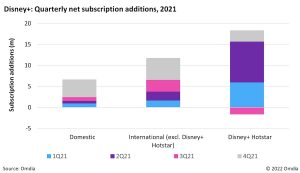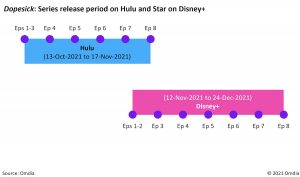
After more than 35 years of operation, TBI is closing its doors and our website will no longer be updated daily. Thank you for all of your support.
TBI Tech & Analysis: How Disney+ is aligning Star with Hulu for int’l growth
The long-term viability of streaming has been under the spotlight in recent weeks but Disney’s results earlier this month again underlined the importance of international growth for US-based firms, writes Omdia’s Matt Evenson.
Disney’s latest quarterly results earlier in February somewhat calmed the nerves of those on Wall Street, after market leader Netflix forecasted net subscriber additions of just 2.5 million for the first quarter of 2022. Omdia noted that Disney+’s 37% year-over-year growth in 2021 was the highest among some of its streaming rivals.
In Q4 2021 specifically, Disney+ added 11.8 million subscriptions, a much stronger number than the 2.1 million added in Q3 2021. This upturn in subscriber growth wouldn’t have been a surprise to Walt Disney Company CEO Bob Chapek, who told the Goldman Sachs Communacopia conference back in September 2021 that Disney’s direct-to-consumer business growth is “not linear”.
While not surprising, it was perhaps reassuring for Chapek to be able to report 4.1 million domestic Disney+ subscription additions in Q4 2021, which account for over 62% of the 6.6 million domestic additions in the 2021 calendar year.
And Disney+ Hotstar (available in India, Indonesia, Malaysia and Thailand) saw a return to subscription growth, after a decline in the previous quarter that Omdia attributed to significant subscriber churn in India in particular, with 2.6 million net subscription additions in Q4.
International improvements & Hulu content
It is, however, Disney+’s segment of other international territories that has experienced improving subscription growth through all quarters in 2021, with 5.1 million added in Q4 alone, and where Disney+’s long-term future is beginning to take shape.
This set of results arrive one year since the introduction of the Star brand tile on the Disney+ platform in many international markets.
This brand broadly houses more adult-oriented content that doesn’t naturally fit within Disney’s other core brands (Marvel, Star Wars, Pixar etc). After a slow start for Star, Disney has recently changed the focus of its advertising in international territories to highlight the range of content that consumers may not readily associate with Disney.
It has been able to do this because more new high profile Hulu shows are heading to Star on Disney+. Recent Omdia analysis highlighted which services have hosted recent Hulu original shows in key European territories and how this has changed in recent months.
But although more Hulu shows are now heading to Disney+ in Europe, they aren’t necessarily being released at the same time, which can be frustrating for consumers and can limit the show’s ability to capture wide audience attention. The first episodes of opioid scandal drama Dopesick launched on Disney+ on 12 November, 2021 to coincide with Disney+ day, but this was a month after the episodes had begun to air on Hulu in the US.
More recently, however, Pam & Tommy premiered with the same number of episodes on both Hulu and Disney+ on 2 February, 2022, suggesting that the release patterns of these Hulu/Star shows may soon align with the global release strategy of Disney+’s key franchise content, such as recent Star Wars series The Book of Boba Fett.
The new advertising campaign comes ahead of Disney+’s expansion into Eastern Europe, the Middle East and parts of Africa in the summer of 2022, where its mix of major franchise content and general entertainment will ensure continued international subscriber growth, even as questions surrounding the long-term profitability of streaming continue to be asked.
Matt Evenson is research analyst for media & entertainment at research powerhouse Omdia, which is part of Informa, as is TBI. He covers the pay-TV and online video markets in Eastern Europe, and researches content strategies for global companies.





